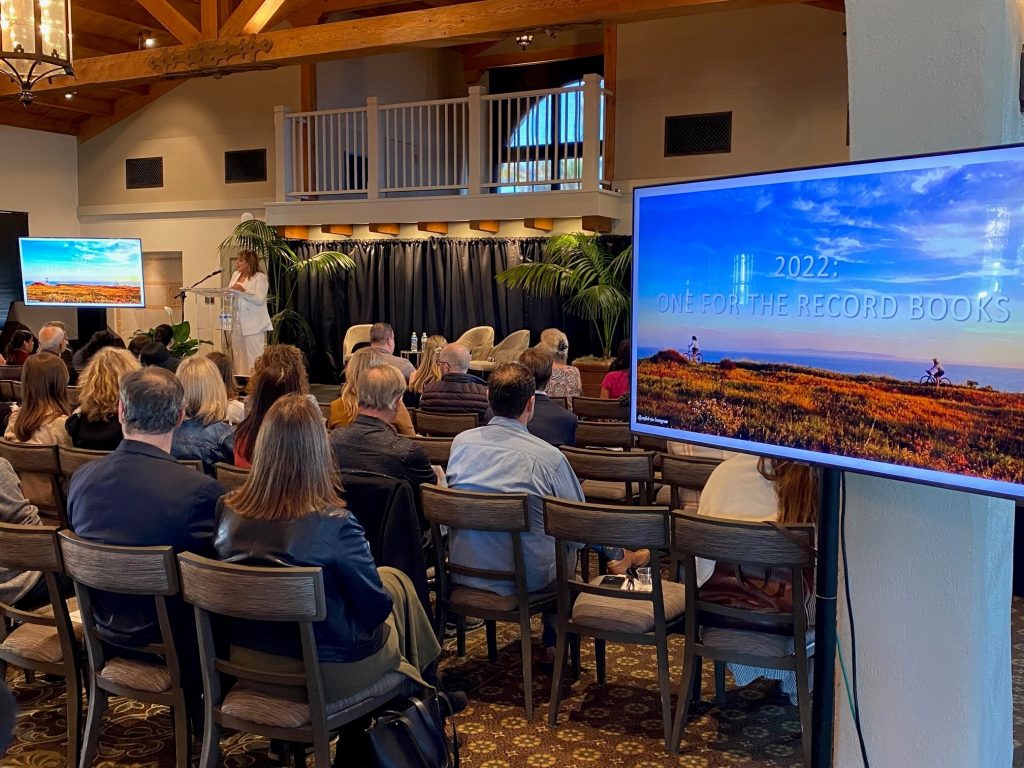Santa Barbara powers tourism rebound on the coast
IN THIS ARTICLE
- Destinations Topic
- Madeleine Benn Author
By Madeleine Benn Thursday, February 2nd, 2023

Despite potential headwinds going into 2023, Santa Barbara had a lot to celebrate in in the past year with regards to the success in the tourism sector.
For the second year in a row, Santa Barbara saw growth, even reaching pre-pandemic levels, Kathy Janega-Dykes, Visit Santa Barbara’s president and CEO said during the Tourism Summit at the Cabrillo Pavilion on Jan. 26.
The Tourism Summit is hosted by Visit Santa Barbara yearly and serves as the tourism industry association for Santa Barbara, Goleta, Montecito and Summerland. Janega-Dykes provided tourism businesses an update on the state of the industry.
“(Last year) was the year we rebuilt hotel occupancy levels and brought leisure industry jobs back to pre-pandemic levels,” said Janega-Dykes. “It’s also the year when our guests were willing to pay 10% more for the Santa Barbara experience than any year on record.”
These highlights translates to Santa Barbara’s first year with hotel room revenue topping a half a billion dollars. Additionally, the Santa Barbara airport was able to report a 20% increase in passenger capacity over the last year.
Despite more recent figurative and literal stormy conditions, Janega-Dykes has a sunny outlook headed into 2023. Visit Santa Barbara has dozens of ads across various different platforms in order to promote Santa Barbara and the South Coast as not only a seasonal destination but a good getaway for road trip commuters as well.
Visit Santa Barbara has also been partnering with local businesses to advocate for the connection between workforce development and recruitment.
“This is the sort of level that our visitors expect. They want businesses open and at capacity,” said Janega-Dykes.
Clayton Reid, CEO of MMGY Global and a board member for the U.S. Travel Association, was the keynote speaker and gave his take on the recession facing the U.S.
While the International Monetary Fund has declared that two-thirds of the world will be in a recession by the end of the year, the U.S. has been in a technical recession since last year, following the two consecutive quarters of negative GDP growth, Reid said.
As such, the travel industry could see some pullback.
“American household savings were at historic highs in 2020, 33% of American households were saving the most they’ve ever had in their lives. Now we’re down to Americans saving just 2%,” said Reid. “Americans have more revolving credit debt than they’ve had in two decades… The good news is, when people take on that debt, they tend to use it for travel.”
During the pandemic, airlines offered smaller travel routs between more niche locales — places like Santa Barbara.
But with traditional pricing, travel routes and passenger capacity reaching normal levels, those smaller destination trips are becoming priced out again, Reid said.
He also discussed some positives for Santa Barbara, such as the potential influx of families, especially affluent families, in the leisure travel market.
Business travel recovery is also not too far behind, with 83% of workers saying they want to take a trip in the next three months.
Reid also said generational wealth as a driver for the travel industry.
He stated that while millennials were set to become one of the most affluent cohorts ever, they are currently valued at half of their parents’ net worth.
Whereas their parents spent two weeks in Buenos Aires, millennials take road trips two hours away for three days. Not necessarily a bad thing for a place like Santa Barbara.
Meanwhile Gen Z is set to inherit $68 trillion as a generation, making them the wealthiest on record. They may be living at home, but they are saving on rent and building portfolios at the same time, he said.
Overall, Reid was adamant that the tourism industry needs to fit their marketing needs to specific demographics of generations coming up or face the consequences of losing out on said markets.
Baby boomers, currently the wealthiest generation, also report a high disability rate. Adjusting the market to the 1 in 4 who identify as having a disability will draw more visitors, and Santa Barbara does a relatively stellar job with its accessibility features already.
“There’s a growing pool of disabled travelers who will travel if you make it easy for them,” said Reid.
Modern travel looks a lot different these days, with the average person mostly booking online. Reid said the average person visits about 34 different travels per day before settling on a final deal.
This phenomenon will likely only continue in the coming years, whether it’s because of the large influence of Google or the TikTok culture that has romanticized traveling to the younger generation, Reid said.









